Construction Innovation: Quality Assurance & Risk Management
VerifiedAdded on 2022/09/02
|7
|1841
|16
Annotated Bibliography
AI Summary
This annotated bibliography focuses on innovation in quality assurance and risk management within the construction industry. It includes annotations of ten different sources, each discussing various aspects of modern construction management techniques. The sources cover topics such as environmental economic models for risk management, the integration of innovation in project risk management, the application of Building Information Modeling (BIM), sustainable approaches to construction, and the implementation of Total Quality Management (TQM). Furthermore, the bibliography explores the use of Information and Communication Technologies (ICT) and lean construction methods to minimize risks and enhance quality. Each annotation summarizes the key points of the referenced article or book, highlighting its relevance to improving quality and managing risks in construction projects. The included research identifies barriers and benefits of quality management, offering insights into how innovative ideas can be successfully incorporated into construction practices for better outcomes.
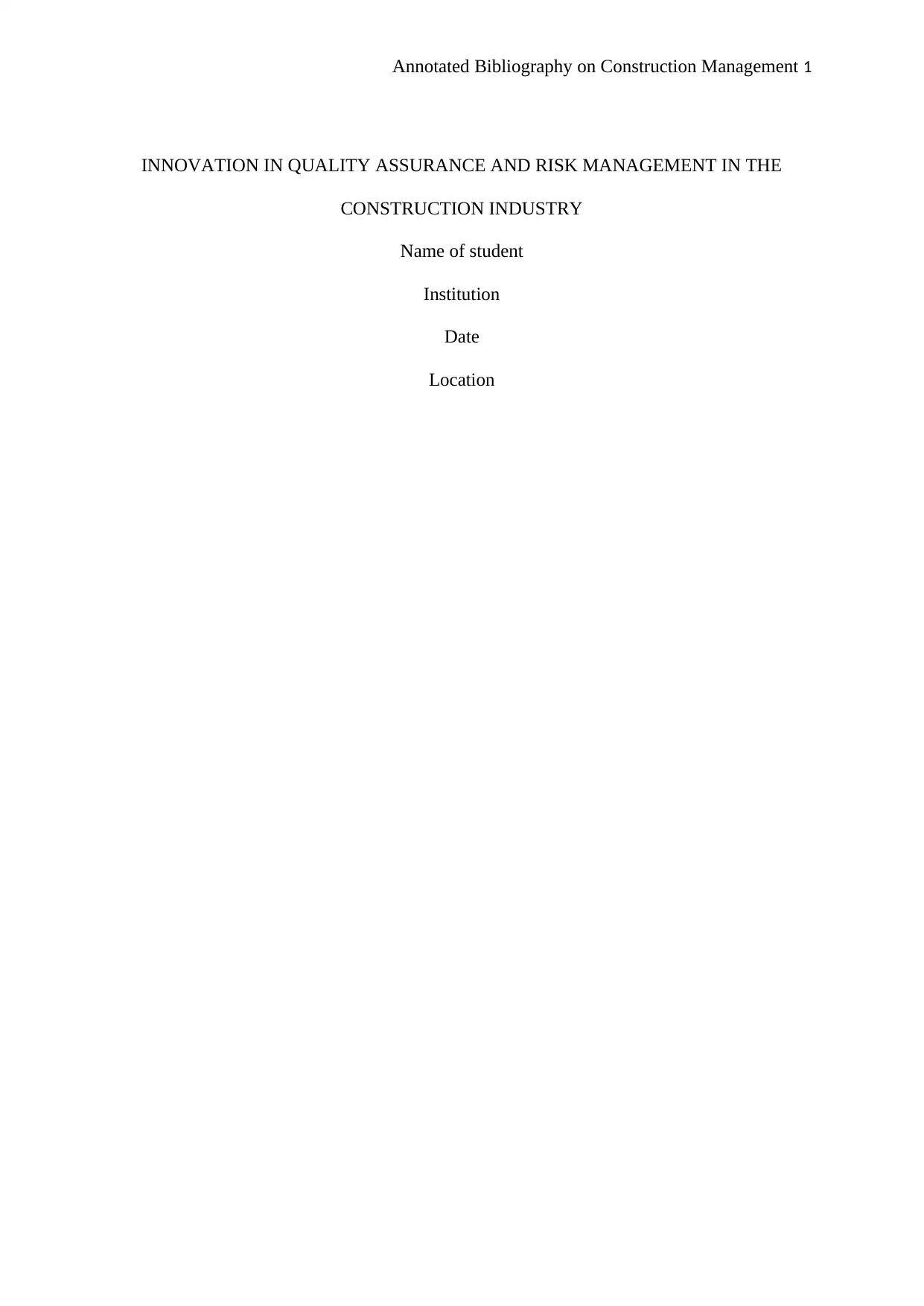
Annotated Bibliography on Construction Management 1
INNOVATION IN QUALITY ASSURANCE AND RISK MANAGEMENT IN THE
CONSTRUCTION INDUSTRY
Name of student
Institution
Date
Location
INNOVATION IN QUALITY ASSURANCE AND RISK MANAGEMENT IN THE
CONSTRUCTION INDUSTRY
Name of student
Institution
Date
Location
Paraphrase This Document
Need a fresh take? Get an instant paraphrase of this document with our AI Paraphraser
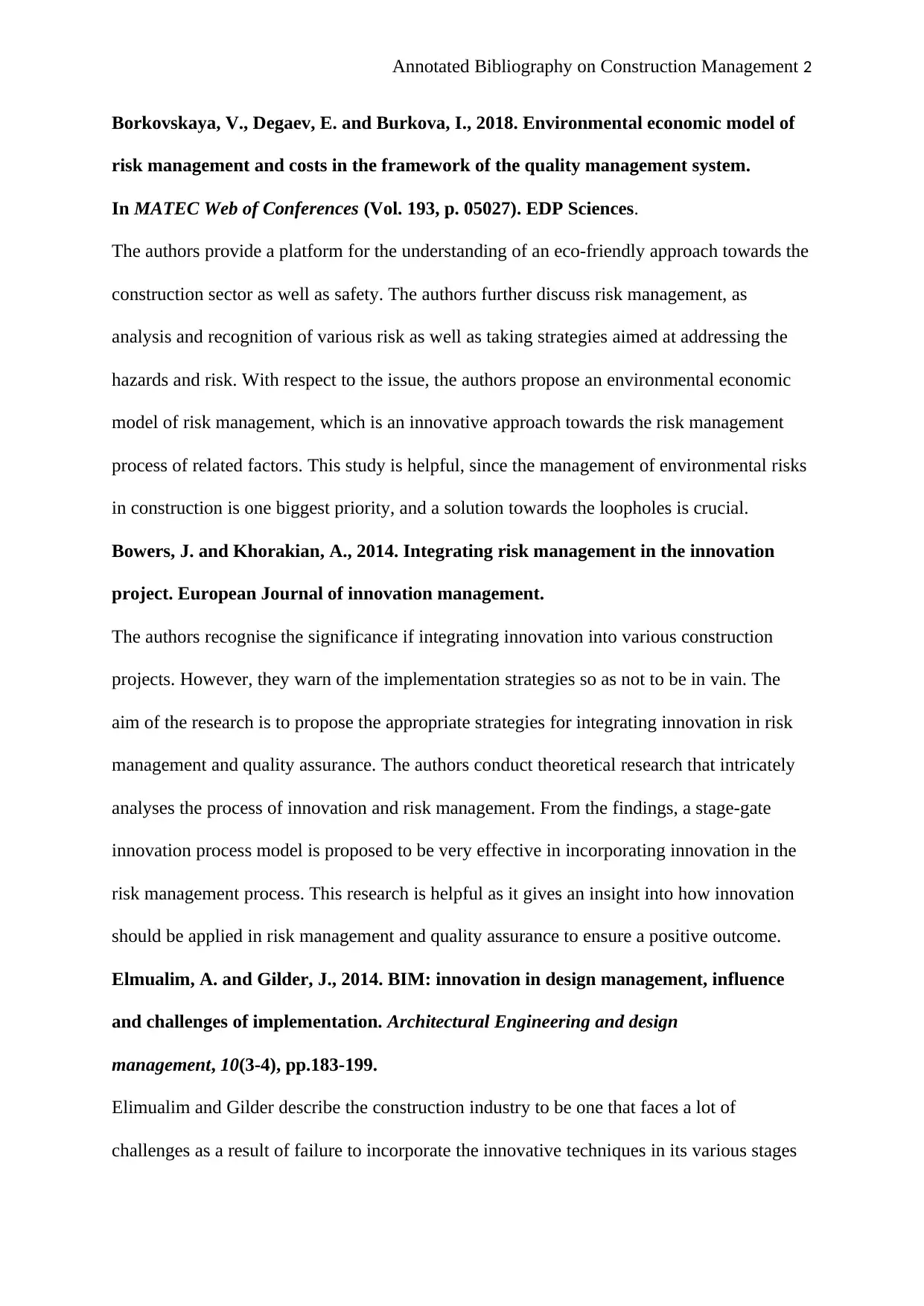
Annotated Bibliography on Construction Management 2
Borkovskaya, V., Degaev, E. and Burkova, I., 2018. Environmental economic model of
risk management and costs in the framework of the quality management system.
In MATEC Web of Conferences (Vol. 193, p. 05027). EDP Sciences.
The authors provide a platform for the understanding of an eco-friendly approach towards the
construction sector as well as safety. The authors further discuss risk management, as
analysis and recognition of various risk as well as taking strategies aimed at addressing the
hazards and risk. With respect to the issue, the authors propose an environmental economic
model of risk management, which is an innovative approach towards the risk management
process of related factors. This study is helpful, since the management of environmental risks
in construction is one biggest priority, and a solution towards the loopholes is crucial.
Bowers, J. and Khorakian, A., 2014. Integrating risk management in the innovation
project. European Journal of innovation management.
The authors recognise the significance if integrating innovation into various construction
projects. However, they warn of the implementation strategies so as not to be in vain. The
aim of the research is to propose the appropriate strategies for integrating innovation in risk
management and quality assurance. The authors conduct theoretical research that intricately
analyses the process of innovation and risk management. From the findings, a stage-gate
innovation process model is proposed to be very effective in incorporating innovation in the
risk management process. This research is helpful as it gives an insight into how innovation
should be applied in risk management and quality assurance to ensure a positive outcome.
Elmualim, A. and Gilder, J., 2014. BIM: innovation in design management, influence
and challenges of implementation. Architectural Engineering and design
management, 10(3-4), pp.183-199.
Elimualim and Gilder describe the construction industry to be one that faces a lot of
challenges as a result of failure to incorporate the innovative techniques in its various stages
Borkovskaya, V., Degaev, E. and Burkova, I., 2018. Environmental economic model of
risk management and costs in the framework of the quality management system.
In MATEC Web of Conferences (Vol. 193, p. 05027). EDP Sciences.
The authors provide a platform for the understanding of an eco-friendly approach towards the
construction sector as well as safety. The authors further discuss risk management, as
analysis and recognition of various risk as well as taking strategies aimed at addressing the
hazards and risk. With respect to the issue, the authors propose an environmental economic
model of risk management, which is an innovative approach towards the risk management
process of related factors. This study is helpful, since the management of environmental risks
in construction is one biggest priority, and a solution towards the loopholes is crucial.
Bowers, J. and Khorakian, A., 2014. Integrating risk management in the innovation
project. European Journal of innovation management.
The authors recognise the significance if integrating innovation into various construction
projects. However, they warn of the implementation strategies so as not to be in vain. The
aim of the research is to propose the appropriate strategies for integrating innovation in risk
management and quality assurance. The authors conduct theoretical research that intricately
analyses the process of innovation and risk management. From the findings, a stage-gate
innovation process model is proposed to be very effective in incorporating innovation in the
risk management process. This research is helpful as it gives an insight into how innovation
should be applied in risk management and quality assurance to ensure a positive outcome.
Elmualim, A. and Gilder, J., 2014. BIM: innovation in design management, influence
and challenges of implementation. Architectural Engineering and design
management, 10(3-4), pp.183-199.
Elimualim and Gilder describe the construction industry to be one that faces a lot of
challenges as a result of failure to incorporate the innovative techniques in its various stages
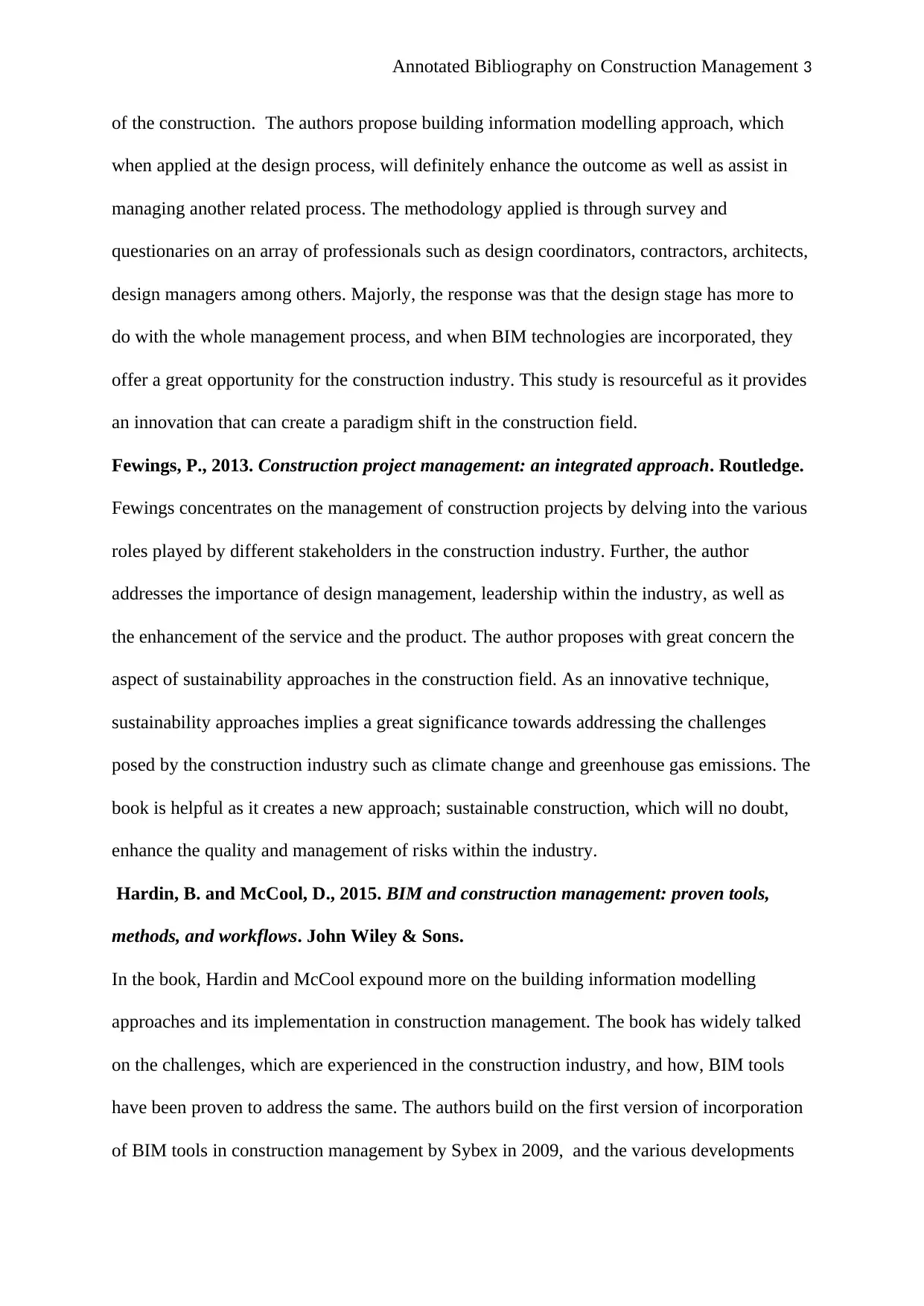
Annotated Bibliography on Construction Management 3
of the construction. The authors propose building information modelling approach, which
when applied at the design process, will definitely enhance the outcome as well as assist in
managing another related process. The methodology applied is through survey and
questionaries on an array of professionals such as design coordinators, contractors, architects,
design managers among others. Majorly, the response was that the design stage has more to
do with the whole management process, and when BIM technologies are incorporated, they
offer a great opportunity for the construction industry. This study is resourceful as it provides
an innovation that can create a paradigm shift in the construction field.
Fewings, P., 2013. Construction project management: an integrated approach. Routledge.
Fewings concentrates on the management of construction projects by delving into the various
roles played by different stakeholders in the construction industry. Further, the author
addresses the importance of design management, leadership within the industry, as well as
the enhancement of the service and the product. The author proposes with great concern the
aspect of sustainability approaches in the construction field. As an innovative technique,
sustainability approaches implies a great significance towards addressing the challenges
posed by the construction industry such as climate change and greenhouse gas emissions. The
book is helpful as it creates a new approach; sustainable construction, which will no doubt,
enhance the quality and management of risks within the industry.
Hardin, B. and McCool, D., 2015. BIM and construction management: proven tools,
methods, and workflows. John Wiley & Sons.
In the book, Hardin and McCool expound more on the building information modelling
approaches and its implementation in construction management. The book has widely talked
on the challenges, which are experienced in the construction industry, and how, BIM tools
have been proven to address the same. The authors build on the first version of incorporation
of BIM tools in construction management by Sybex in 2009, and the various developments
of the construction. The authors propose building information modelling approach, which
when applied at the design process, will definitely enhance the outcome as well as assist in
managing another related process. The methodology applied is through survey and
questionaries on an array of professionals such as design coordinators, contractors, architects,
design managers among others. Majorly, the response was that the design stage has more to
do with the whole management process, and when BIM technologies are incorporated, they
offer a great opportunity for the construction industry. This study is resourceful as it provides
an innovation that can create a paradigm shift in the construction field.
Fewings, P., 2013. Construction project management: an integrated approach. Routledge.
Fewings concentrates on the management of construction projects by delving into the various
roles played by different stakeholders in the construction industry. Further, the author
addresses the importance of design management, leadership within the industry, as well as
the enhancement of the service and the product. The author proposes with great concern the
aspect of sustainability approaches in the construction field. As an innovative technique,
sustainability approaches implies a great significance towards addressing the challenges
posed by the construction industry such as climate change and greenhouse gas emissions. The
book is helpful as it creates a new approach; sustainable construction, which will no doubt,
enhance the quality and management of risks within the industry.
Hardin, B. and McCool, D., 2015. BIM and construction management: proven tools,
methods, and workflows. John Wiley & Sons.
In the book, Hardin and McCool expound more on the building information modelling
approaches and its implementation in construction management. The book has widely talked
on the challenges, which are experienced in the construction industry, and how, BIM tools
have been proven to address the same. The authors build on the first version of incorporation
of BIM tools in construction management by Sybex in 2009, and the various developments
⊘ This is a preview!⊘
Do you want full access?
Subscribe today to unlock all pages.

Trusted by 1+ million students worldwide
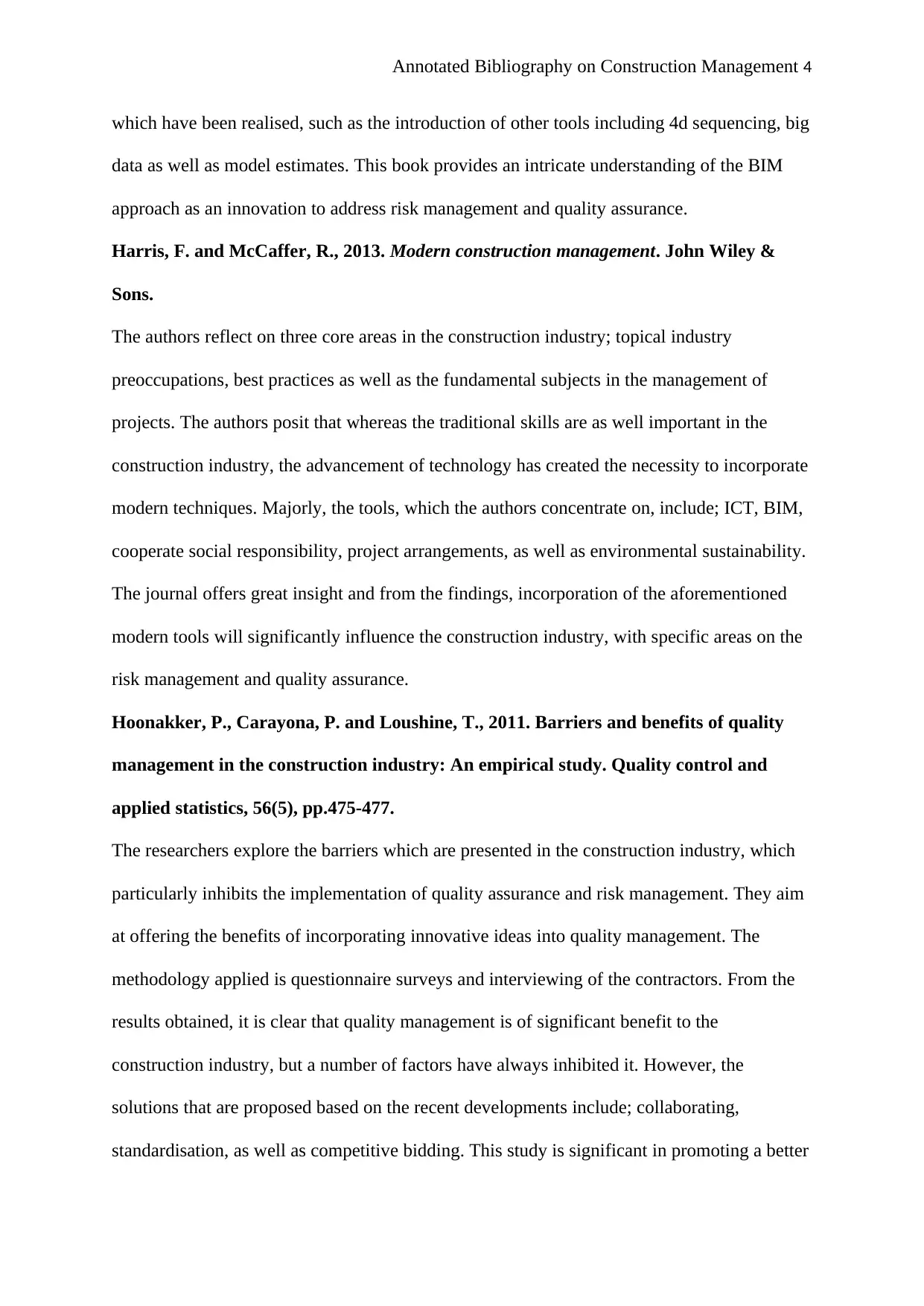
Annotated Bibliography on Construction Management 4
which have been realised, such as the introduction of other tools including 4d sequencing, big
data as well as model estimates. This book provides an intricate understanding of the BIM
approach as an innovation to address risk management and quality assurance.
Harris, F. and McCaffer, R., 2013. Modern construction management. John Wiley &
Sons.
The authors reflect on three core areas in the construction industry; topical industry
preoccupations, best practices as well as the fundamental subjects in the management of
projects. The authors posit that whereas the traditional skills are as well important in the
construction industry, the advancement of technology has created the necessity to incorporate
modern techniques. Majorly, the tools, which the authors concentrate on, include; ICT, BIM,
cooperate social responsibility, project arrangements, as well as environmental sustainability.
The journal offers great insight and from the findings, incorporation of the aforementioned
modern tools will significantly influence the construction industry, with specific areas on the
risk management and quality assurance.
Hoonakker, P., Carayona, P. and Loushine, T., 2011. Barriers and benefits of quality
management in the construction industry: An empirical study. Quality control and
applied statistics, 56(5), pp.475-477.
The researchers explore the barriers which are presented in the construction industry, which
particularly inhibits the implementation of quality assurance and risk management. They aim
at offering the benefits of incorporating innovative ideas into quality management. The
methodology applied is questionnaire surveys and interviewing of the contractors. From the
results obtained, it is clear that quality management is of significant benefit to the
construction industry, but a number of factors have always inhibited it. However, the
solutions that are proposed based on the recent developments include; collaborating,
standardisation, as well as competitive bidding. This study is significant in promoting a better
which have been realised, such as the introduction of other tools including 4d sequencing, big
data as well as model estimates. This book provides an intricate understanding of the BIM
approach as an innovation to address risk management and quality assurance.
Harris, F. and McCaffer, R., 2013. Modern construction management. John Wiley &
Sons.
The authors reflect on three core areas in the construction industry; topical industry
preoccupations, best practices as well as the fundamental subjects in the management of
projects. The authors posit that whereas the traditional skills are as well important in the
construction industry, the advancement of technology has created the necessity to incorporate
modern techniques. Majorly, the tools, which the authors concentrate on, include; ICT, BIM,
cooperate social responsibility, project arrangements, as well as environmental sustainability.
The journal offers great insight and from the findings, incorporation of the aforementioned
modern tools will significantly influence the construction industry, with specific areas on the
risk management and quality assurance.
Hoonakker, P., Carayona, P. and Loushine, T., 2011. Barriers and benefits of quality
management in the construction industry: An empirical study. Quality control and
applied statistics, 56(5), pp.475-477.
The researchers explore the barriers which are presented in the construction industry, which
particularly inhibits the implementation of quality assurance and risk management. They aim
at offering the benefits of incorporating innovative ideas into quality management. The
methodology applied is questionnaire surveys and interviewing of the contractors. From the
results obtained, it is clear that quality management is of significant benefit to the
construction industry, but a number of factors have always inhibited it. However, the
solutions that are proposed based on the recent developments include; collaborating,
standardisation, as well as competitive bidding. This study is significant in promoting a better
Paraphrase This Document
Need a fresh take? Get an instant paraphrase of this document with our AI Paraphraser
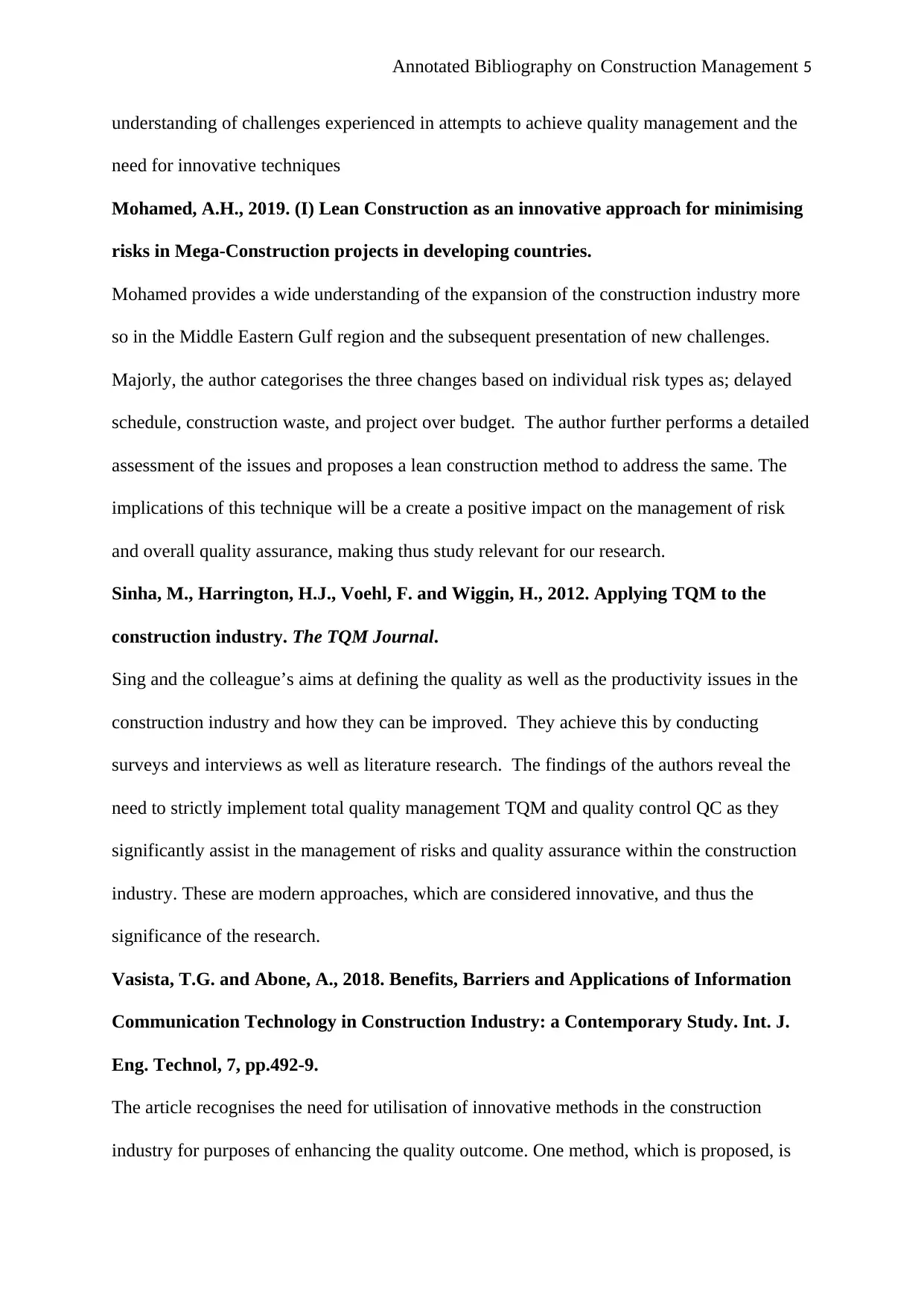
Annotated Bibliography on Construction Management 5
understanding of challenges experienced in attempts to achieve quality management and the
need for innovative techniques
Mohamed, A.H., 2019. (I) Lean Construction as an innovative approach for minimising
risks in Mega-Construction projects in developing countries.
Mohamed provides a wide understanding of the expansion of the construction industry more
so in the Middle Eastern Gulf region and the subsequent presentation of new challenges.
Majorly, the author categorises the three changes based on individual risk types as; delayed
schedule, construction waste, and project over budget. The author further performs a detailed
assessment of the issues and proposes a lean construction method to address the same. The
implications of this technique will be a create a positive impact on the management of risk
and overall quality assurance, making thus study relevant for our research.
Sinha, M., Harrington, H.J., Voehl, F. and Wiggin, H., 2012. Applying TQM to the
construction industry. The TQM Journal.
Sing and the colleague’s aims at defining the quality as well as the productivity issues in the
construction industry and how they can be improved. They achieve this by conducting
surveys and interviews as well as literature research. The findings of the authors reveal the
need to strictly implement total quality management TQM and quality control QC as they
significantly assist in the management of risks and quality assurance within the construction
industry. These are modern approaches, which are considered innovative, and thus the
significance of the research.
Vasista, T.G. and Abone, A., 2018. Benefits, Barriers and Applications of Information
Communication Technology in Construction Industry: a Contemporary Study. Int. J.
Eng. Technol, 7, pp.492-9.
The article recognises the need for utilisation of innovative methods in the construction
industry for purposes of enhancing the quality outcome. One method, which is proposed, is
understanding of challenges experienced in attempts to achieve quality management and the
need for innovative techniques
Mohamed, A.H., 2019. (I) Lean Construction as an innovative approach for minimising
risks in Mega-Construction projects in developing countries.
Mohamed provides a wide understanding of the expansion of the construction industry more
so in the Middle Eastern Gulf region and the subsequent presentation of new challenges.
Majorly, the author categorises the three changes based on individual risk types as; delayed
schedule, construction waste, and project over budget. The author further performs a detailed
assessment of the issues and proposes a lean construction method to address the same. The
implications of this technique will be a create a positive impact on the management of risk
and overall quality assurance, making thus study relevant for our research.
Sinha, M., Harrington, H.J., Voehl, F. and Wiggin, H., 2012. Applying TQM to the
construction industry. The TQM Journal.
Sing and the colleague’s aims at defining the quality as well as the productivity issues in the
construction industry and how they can be improved. They achieve this by conducting
surveys and interviews as well as literature research. The findings of the authors reveal the
need to strictly implement total quality management TQM and quality control QC as they
significantly assist in the management of risks and quality assurance within the construction
industry. These are modern approaches, which are considered innovative, and thus the
significance of the research.
Vasista, T.G. and Abone, A., 2018. Benefits, Barriers and Applications of Information
Communication Technology in Construction Industry: a Contemporary Study. Int. J.
Eng. Technol, 7, pp.492-9.
The article recognises the need for utilisation of innovative methods in the construction
industry for purposes of enhancing the quality outcome. One method, which is proposed, is
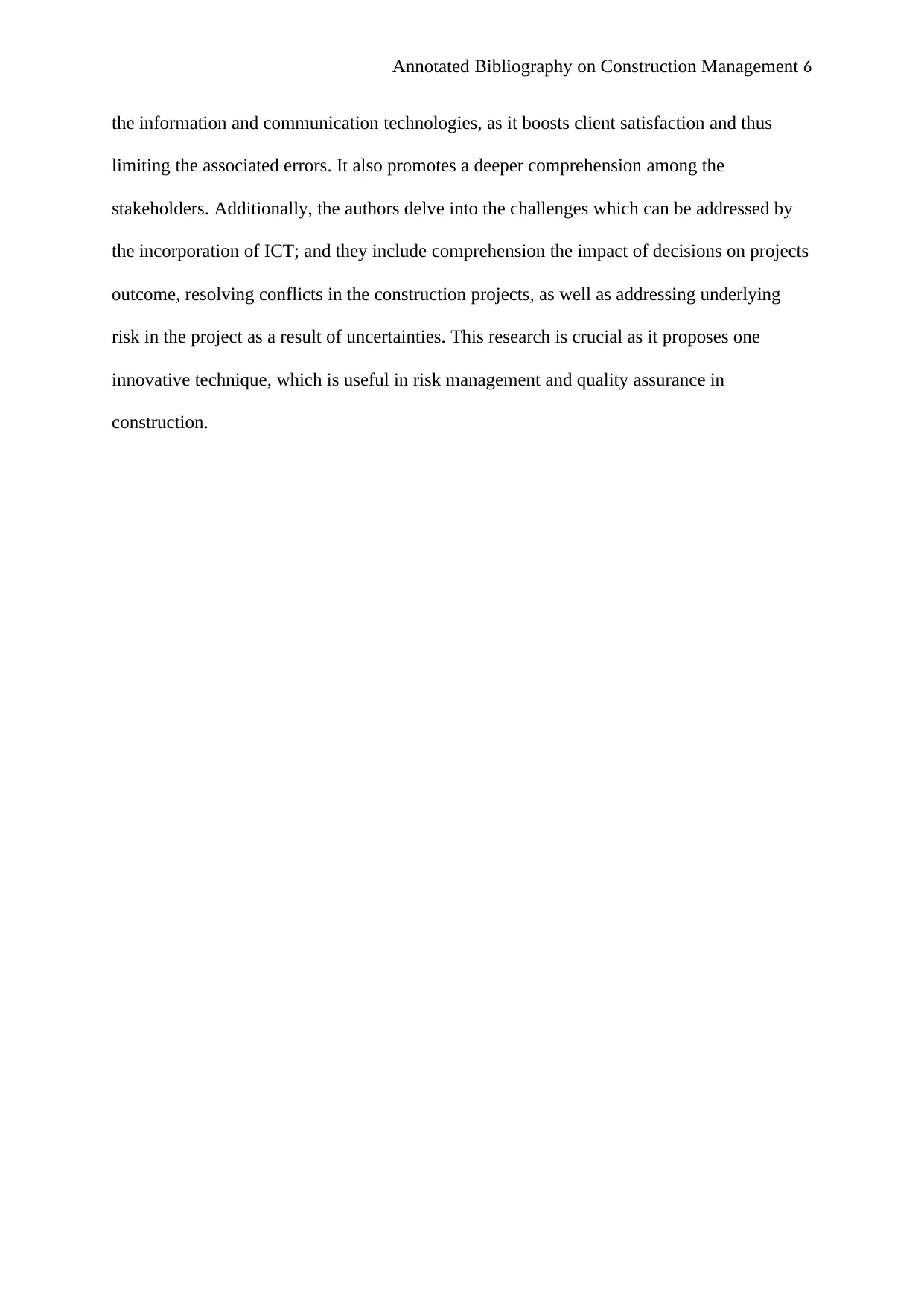
Annotated Bibliography on Construction Management 6
the information and communication technologies, as it boosts client satisfaction and thus
limiting the associated errors. It also promotes a deeper comprehension among the
stakeholders. Additionally, the authors delve into the challenges which can be addressed by
the incorporation of ICT; and they include comprehension the impact of decisions on projects
outcome, resolving conflicts in the construction projects, as well as addressing underlying
risk in the project as a result of uncertainties. This research is crucial as it proposes one
innovative technique, which is useful in risk management and quality assurance in
construction.
the information and communication technologies, as it boosts client satisfaction and thus
limiting the associated errors. It also promotes a deeper comprehension among the
stakeholders. Additionally, the authors delve into the challenges which can be addressed by
the incorporation of ICT; and they include comprehension the impact of decisions on projects
outcome, resolving conflicts in the construction projects, as well as addressing underlying
risk in the project as a result of uncertainties. This research is crucial as it proposes one
innovative technique, which is useful in risk management and quality assurance in
construction.
⊘ This is a preview!⊘
Do you want full access?
Subscribe today to unlock all pages.

Trusted by 1+ million students worldwide
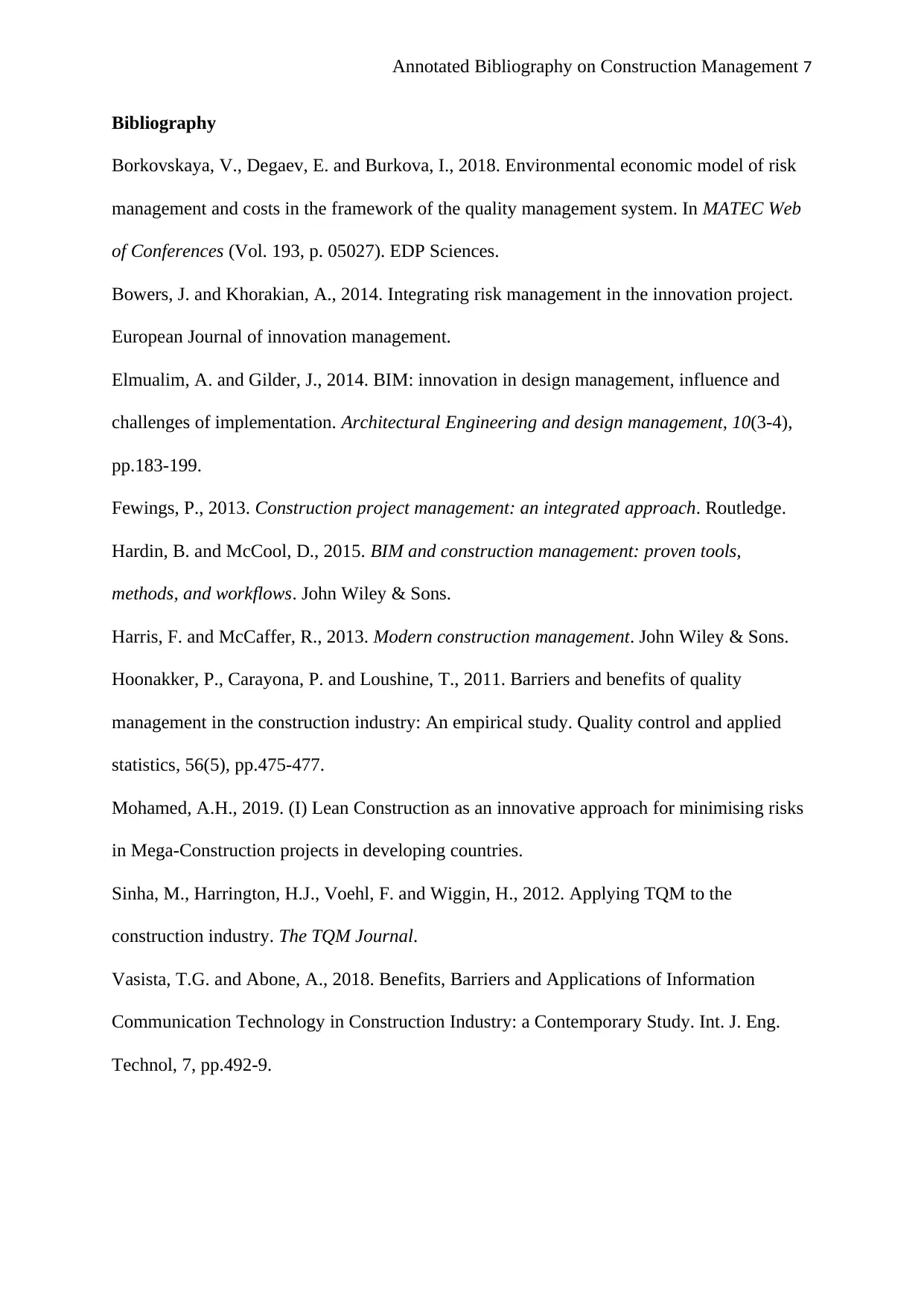
Annotated Bibliography on Construction Management 7
Bibliography
Borkovskaya, V., Degaev, E. and Burkova, I., 2018. Environmental economic model of risk
management and costs in the framework of the quality management system. In MATEC Web
of Conferences (Vol. 193, p. 05027). EDP Sciences.
Bowers, J. and Khorakian, A., 2014. Integrating risk management in the innovation project.
European Journal of innovation management.
Elmualim, A. and Gilder, J., 2014. BIM: innovation in design management, influence and
challenges of implementation. Architectural Engineering and design management, 10(3-4),
pp.183-199.
Fewings, P., 2013. Construction project management: an integrated approach. Routledge.
Hardin, B. and McCool, D., 2015. BIM and construction management: proven tools,
methods, and workflows. John Wiley & Sons.
Harris, F. and McCaffer, R., 2013. Modern construction management. John Wiley & Sons.
Hoonakker, P., Carayona, P. and Loushine, T., 2011. Barriers and benefits of quality
management in the construction industry: An empirical study. Quality control and applied
statistics, 56(5), pp.475-477.
Mohamed, A.H., 2019. (I) Lean Construction as an innovative approach for minimising risks
in Mega-Construction projects in developing countries.
Sinha, M., Harrington, H.J., Voehl, F. and Wiggin, H., 2012. Applying TQM to the
construction industry. The TQM Journal.
Vasista, T.G. and Abone, A., 2018. Benefits, Barriers and Applications of Information
Communication Technology in Construction Industry: a Contemporary Study. Int. J. Eng.
Technol, 7, pp.492-9.
Bibliography
Borkovskaya, V., Degaev, E. and Burkova, I., 2018. Environmental economic model of risk
management and costs in the framework of the quality management system. In MATEC Web
of Conferences (Vol. 193, p. 05027). EDP Sciences.
Bowers, J. and Khorakian, A., 2014. Integrating risk management in the innovation project.
European Journal of innovation management.
Elmualim, A. and Gilder, J., 2014. BIM: innovation in design management, influence and
challenges of implementation. Architectural Engineering and design management, 10(3-4),
pp.183-199.
Fewings, P., 2013. Construction project management: an integrated approach. Routledge.
Hardin, B. and McCool, D., 2015. BIM and construction management: proven tools,
methods, and workflows. John Wiley & Sons.
Harris, F. and McCaffer, R., 2013. Modern construction management. John Wiley & Sons.
Hoonakker, P., Carayona, P. and Loushine, T., 2011. Barriers and benefits of quality
management in the construction industry: An empirical study. Quality control and applied
statistics, 56(5), pp.475-477.
Mohamed, A.H., 2019. (I) Lean Construction as an innovative approach for minimising risks
in Mega-Construction projects in developing countries.
Sinha, M., Harrington, H.J., Voehl, F. and Wiggin, H., 2012. Applying TQM to the
construction industry. The TQM Journal.
Vasista, T.G. and Abone, A., 2018. Benefits, Barriers and Applications of Information
Communication Technology in Construction Industry: a Contemporary Study. Int. J. Eng.
Technol, 7, pp.492-9.
1 out of 7
Related Documents
Your All-in-One AI-Powered Toolkit for Academic Success.
+13062052269
info@desklib.com
Available 24*7 on WhatsApp / Email
![[object Object]](/_next/static/media/star-bottom.7253800d.svg)
Unlock your academic potential
Copyright © 2020–2025 A2Z Services. All Rights Reserved. Developed and managed by ZUCOL.





